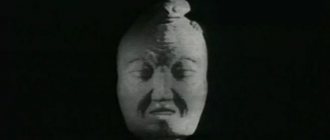Obsessive thoughts are uncontrollable urges that arise on a subconscious level. They lead to fears and anxieties, inadequate negative fantasies, and deterioration of mental health. Without proper treatment, obsessions become the cause of depressive moods, neuroses, schizophrenia, mental exhaustion, and a hermit lifestyle. The main characteristics of the disease are as follows:
- the individual does not influence the appearance of anxious and bad thoughts, they appear against his will;
- ideas that forcibly invade the mind do not arise as a result of habitual conclusions, but are isolated, alien images;
- the disease cannot be eliminated from your life with just one effort of will;
- Symptoms include severe anxiety, increased irritability;
- the patient does not lose clarity of mind and recognizes his illness.
It is precisely because of the awareness of the deplorability of his situation that the patient feels bad. He admits his deviations, but cannot fight them. All attempts to eliminate obsessive thoughts from consciousness cause even greater anxiety and fear. It is easy to convince the patient that all his incomprehensible fantasies have no proper basis. The person admits this, but the disease continues to progress. More and more new obsessions appear. Here are the most striking examples of “sticky” thoughts:
- fears about the spread and infection of diseases;
- adherence to principles in ensuring order and symmetry;
- uncontrolled obsessive counting;
- fear of force majeure, the end of the world;
- groundless and unreasoned exclusion of specific actions;
- thoughts about faith, sex, excessive aggressiveness that arise without the desire of the patient.
Obsessions lead to negative behavior and a state of increased tension. The patient himself cannot cope with his experiences, although he admits that he has a problem and that they are unfounded. It is possible to improve your condition and get rid of false ideas of reality only by receiving competent medical care.
Treatment of obsessive thoughts
The Salvation Clinic treats obsessive thoughts using progressive techniques and proven pharmacotherapy. Our staff includes highly qualified psychologists and psychotherapists who have experience and the opportunity to travel to various international conferences. The clinic provides decent conditions for keeping patients, nutritious food, and leisure. The patients do not need anything. It is possible to install an individual nursing station and rent a VIP room. The clinic has specialized security. No one will be able to enter or leave unnoticed. We strive to alleviate the condition of our patients and bring recovery closer. Contacting our center will improve the patient’s quality of life and provide the opportunity for a full-fledged existence.
Patients are treated individually. The program is developed on the basis of long-term observations of the patient’s behavior, his state of health, tests, taking into account age. The greatest effect of treatment is achieved with a combination of psychotherapy and drug therapy. Medicines (tranquilizers, antidepressants and antipsychotics) allow you to:
- correct neurotic symptoms;
- remove anxiety and fears;
- control mood and behavior.
Psychotherapy is an integral part of treating obsessive thoughts. Through individual counseling you can:
- understand the nature of the occurrence of deviations;
- eliminate the cause that led to the disease;
- eliminate fears and anxieties;
- develop stress resistance and self-confidence;
- eliminate depressive moods;
- teach how to manage symptoms;
- help a person socialize.
In their practice, our center’s specialists use the following approaches:
- Cognitive behavioral therapy. Based on the theory of behaviorism and the cognitive approach. The latter implies that deviations in mental development are provoked by illogical thinking and incorrect beliefs of the individual, by eliminating which it will be possible to get rid of obsessive thoughts and anxieties. Adherents of behaviorism recognize that the main influence on the mental development of an individual and his behavior is exerted by genetic predisposition, but they also attach important importance to environmental factors. By eliminating support for undesirable behaviors and encouraging desirable ones, a person's habits and lifestyle can be changed.
- Hypno-suggestive techniques. Verbal and non-verbal influence is made on the consciousness of the individual in order to introduce the necessary attitudes and programs. During the session, control is removed, attention is reduced, and the opportunity to program consciousness opens up. As a result of hypnosis treatment, motivation to action, changes in state and behavior are produced. The suggestive instructions given by the doctor penetrate deeply into the patient’s subconscious, which ensures positive dynamics of treatment. When using hypno-suggestive methods, depression, neurosis, phobias, alcoholism, smoking, drug addiction are successfully treated, and obsessions are eliminated.
- Autotraining. Allows you to restore the function of self-regulation impaired due to stress. The method is based on the use of self-hypnosis, self-education, and muscle relaxation. The advantage of auto-training is the involvement of the patient in the treatment process. There are two stages of training: higher and lower. At the initial stage, relaxation exercises, training of the cardiovascular system, and training in the principles of proper breathing are performed. As a result of treatment, the patient’s general well-being, blood supply to the brain and internal organs improves, the heartbeat normalizes, and headaches are relieved. At the highest stage, training is carried out to induce certain complex experiences by introducing the patient into trance states of varying depth and intensity.
We guarantee the correct diagnosis and improvement of the patient’s condition. The treatment regimen for obsessive thoughts is developed collectively. We focus on the complete elimination of symptoms and a return to an independent active life without worries and restrictions.
Develop a Beginner's Mind
In Zen Buddhism there is the concept of shoshin, beginner's consciousness. The mind of a beginner is open to new things; it is not initially filled with thoughts. The person knows nothing and does not think like an expert. Newbie consciousness is the opposite of anxious consciousness.
Anxiety tends to take over and control everything; it tells you what to worry about and what to be afraid of. She doesn't accept anything new and tries to control your actions. Because of anxiety, we close ourselves off from the rest of the world into our own.
Shoshin confronts beliefs formed by an anxious mind. Once you have a beginner's mind, you:
- you stop interpreting everyone’s actions and everything that happens;
- free yourself from the fear of preconceptions about what might happen if you are right;
- you are distracted from the endless anxiety that arises from the habit of being biased towards everything.
Setting a goal can train a beginner's mind. Anxiety will impose its predetermined thoughts on you, prompt questions, but you can train your brain to be open to alternative possibilities. The following exercises will help you at any time of the day or night.
- Develop curiosity. Try to think in new ways, explore new ideas, discover new facets of the world around you. Ask questions and look for different answers.
- Be fully present in every moment. Be open to experiences in the present rather than getting stuck in worries about the past or future.
- Let go of worry. After listening to what your worries are whispering to you, add “...but I don’t know” after each phrase. What seems certain to you under the influence of anxiety will become uncertain.
Obsessive thoughts and fears
Obsessions bring significant discomfort to the patient’s life. He cannot get rid of the desire to succumb to them, to correct the situation. What causes compulsions? This is a syndrome that occurs at certain intervals as a result of compulsive behavior. In its absence, the patient experiences a feeling of anxiety. Resistance to urges ceases when a person can no longer resist the obsessions. The most common “rituals” in this case:
- cleansing (a person is obsessed with the idea of bringing perfect cleanliness to the house, this also includes frequent washing of hands and body);
- satiety (the patient has an excessive appetite amid concern about controlling his body weight);
- ensuring security (a person constantly checks whether the door is locked, whether all electrical or gas appliances are turned off;
- observance of rationality (the patient zealously adheres to the regime, places objects in a certain order, steps over cracks in the asphalt);
- bookkeeping (the patient involuntarily monitors the number of things around him).
A person’s behavior during forcibly invading fantasies may look quite ordinary and does not arouse suspicion. However, a person is unable to renounce performing compulsive “rituals” due to anxiety that something terrible might happen. He is simply forced to carry out the actions to which his anxious thoughts are pushing him. Unfortunately, after the ritual, the person does not feel relief. And the fear of trouble pushes him to even more fanatical execution of actions imposed by alien thoughts. With this behavior, obsessive-compulsive disorder develops. The disease progresses mainly between the ages of 10 and 30 years. People with a high level of intelligence are most susceptible to the disease. In addition to this disease associated with obsessions, there are others.
Phobia
Translated from Greek, this term means “unhealthy fear.” It arises as a result of certain actions, situations, objects, people, animals. A person is panicky afraid of an irritant that causes fear. In some cases, phobias cause an inappropriate reaction, leading to aggression. Deviation can occur as a result of severe stress, overwork, nervous tension, or mental disorder. To date, a large number of phobias have been identified. The most common among them are:
- fear of open/enclosed spaces or crowded places;
- fear of swimming;
- fear of blood;
- fear of specific animals, insects;
- fear of loneliness;
- fear of touching money.
Phobias are often accompanied by panic attacks. A person imagines a quick end, as a result of which he may experience:
- numbness of hands and feet;
- labored breathing;
- discomfort in the heart area;
- diarrhea;
- dizziness.
All this affects the patient’s quality of life and requires immediate medical intervention. Treatment for a phobia depends on its type. In this case, he uses the principle of “knocking out a wedge with a wedge.” The patient is allowed to face his fear. However, this technique is associated with a strong emotional shock and does not always pay off.
Neurasthenia
The disease is characterized by excessive irritability, rapid fatigue, and loss of ability for prolonged mental and physical work. Pathology can be triggered by psychological trauma, nervous tension at work, chronic lack of sleep, lack of proper rest, chronic intoxication, infectious diseases, unhealthy diet, and endocrine disorders. The disease is accompanied by:
- frequent headaches;
- disruptions in the functioning of the cardiovascular system;
- disturbance of sleep and wakefulness;
- diarrhea/constipation.
The most favorable prognosis for treating neurasthenia at the initial stage. A change of environment, work, streamlining of the daily routine, and proper rest can help. In advanced cases, hospitalization in a specialized hospital and the prescription of pharmacotherapy, including restorative drugs, antidepressants and tranquilizers, may be required. With proper treatment, complete recovery can be achieved.
Schizophrenia
Schizophrenia is a difficult to diagnose complex mental disorder associated with inadequacy, unpredictability of behavior, insanity, illogical thinking, and detachment from society. The disease is most common in people aged 14 to 35 years. Symptoms include:
- delusional ideas;
- depressive moods;
- decreased mental and motor activity;
- deterioration in concentration;
- persecution mania;
- auditory hallucinations;
- bouts of hysteria or crying for no reason;
- delusions of grandeur;
- slurred speech;
- sloppy appearance.
The disease can be triggered by severe stress, mental stress, and heredity. Although there have been cases of sudden onset of schizophrenia with complete mental comfort.
To make an accurate diagnosis, it is necessary to observe the patient’s behavior for a long time (at least 6 months), communicate with the patient’s relatives, general and biochemical blood tests, a clinical study of the immune status, hormonal profile, magnetic resonance therapy to exclude brain diseases that may cause tumors, abscesses, and viral encephalitis.
Symptoms of obsessive-compulsive disorder
Obsessions, or intrusive thoughts
Obsessions are recurring thoughts, images, or urges that cause anxiety, worry, shame, or disgust. They arise uncontrollably, and patients cannot drive them away through logical arguments. A person with OCD tries to suppress such obsessions by “interrupting” them with other thoughts or actions. Typical obsessive thoughts in OCD are the fear of contamination, the need for symmetry or precision, certain immoral ideas or impulses that are alien to the personality of the patient himself. Obsessions can be triggered by any events that somehow indirectly remind of their object - for example, an extraneous cough, contact with a “non-sterile” object (handrails, door handles, etc.)
Compulsions, or obsessive actions
To combat obsessions, OCD patients perform defensive, repetitive actions (compulsions). Compulsions are similar to peculiar rituals that “prevent” the embodiment of negative thoughts and fears. Washing hands too often, wiping objects, constantly checking electrical appliances, repeating words, counting. For example, to make sure that the door is locked, a person with OCD needs to pull the door handle a specific number of times (and count the times). After such a ritual, the patient feels relief for a while, but then the obsessive thoughts return, and everything repeats again and again. In severe cases, compulsions can take up a huge amount of the patient's time, interfering with daily activities. A patient with OCD describes his condition as follows:
I've always had a terrible fear of bacteria, to the point where I washed my hands dozens of times a day, but I didn't think it had anything to do with OCD. Then it became unbearable for me to be at home in the same clothes in which I went out, I could not eat bread in the place where I grabbed it with my hands, I carefully examined all the dishes before using them. It began to take up more and more time and attention and interfered with my life.
At the same time, compulsions are often accompanied by a feeling of depression and melancholy, because a person with OCD does not lose the awareness that such actions are irrational and meaningless.
What are obsessions and compulsions?
Most often, obsessive thoughts and fears are centered around certain topics. The most common of them are cleanliness and sterility, perfectionism, loss of control, religiosity, and forbidden sexual acts. The rituals that “protect” a person with OCD from these thoughts and “prevent” fears can vary. Most often, the nature of the obsession determines a certain type of compulsion.
| Obsessions | Compulsions |
Fear of pollution
| Washing and cleaning
|
Loss of control over yourself or a situation
An OCD patient is afraid of accidentally hitting her child. The patient is tormented by the fear of dropping something along the way. | Examination
The patient constantly checks whether he is okay, hides all knives and other sharp objects from herself. Every few meters along the way, the patient turns around to look for a possibly fallen item. |
Obsession with the “ideal”
The patient perceives the number “three” as special and correct; inconsistency with this number causes him anxiety. | Repetition and ordering
The patient begins to repeat each action three times: for example, rereads sentences three times, blinks three times, etc. The patient holds her breath while performing these actions, feeling that this “protects” her from negative experiences. |
Unwanted sexual thoughts
The patient is tormented by fear of attraction to older people | Mental actions
The patient avoids looking them in the eyes, repeats a certain phrase in his mind that would “drown out” possible unwanted thoughts |
It has been noticed that the stronger the patient’s desire to resist obsessive thoughts, the more clearly the obsessive-compulsive neurosis manifests itself. The efforts not only do not give the desired result, they further aggravate the problem - the obsessions return in an even more pronounced form.
When such conditions occur, it is very important not to try to cope with the problem on your own - only a doctor can provide effective professional assistance.
Causes of obsessive thoughts
It is difficult to establish exactly the nature of the occurrence of alien anxious thoughts. This is most associated with the underlying disease. May also affect:
- heredity;
- hormonal imbalance, due to which there is a dysfunction of the brain;
- psychological trauma;
- severe stress;
- sensitive temperament;
- pregnancy;
- disability;
- the presence of protracted infectious diseases.
A qualified psychiatrist can determine the causes of obsessive thoughts. Required:
- personal consultation;
- conducting experiments to see the overall clinical picture;
- interviewing the patient's relatives;
- observing his behavior;
- use of a neurophysiological test system and neurotest;
- carrying out laboratory tests.
Treatment of obsessions is carried out in conjunction with the underlying disease. Depending on the patient’s condition, it can be performed in a hospital or in an outpatient setting.
How to get rid of obsessive thoughts in your head
Obsessions are a real reason to visit a doctor. Only with the help of a specialist will it be possible to eliminate inappropriate ideas. You should not try to find a way to improve your well-being on your own. Self-medication can lead to worsening of the condition, progression of the disease, dependence on drugs and alcohol, in which the patient seeks solace. However, they only aggravate the situation, as they can cause delusions and hallucinations.
Heart-to-heart conversations help with obsessions. Relatives and people with similar problems will understand better. It may be advisable to sign up for group psychotherapy. However, even the closest people are not always ready to listen. Optimally, contact a good psychiatrist. In addition, you must:
- understand your desires;
- do not forget about self-control;
- adhere to the treatment regimen;
- learn more about your condition;
- accept the problem;
- realize the need for treatment;
- get enough sleep;
- adhere to the rules of good nutrition;
- give up alcohol and other psychoactive substances;
- lead an active lifestyle;
- avoid nervous fatigue and anxiety;
- be distracted by relaxing with family and friends, building a career;
- there is no need to allow obsession to interfere with a full existence.
Our clinic specialists are ready to listen to you right now. We provide on-site consultations and guarantee complete confidentiality. Highly qualified doctors will be able to correctly diagnose and offer an effective solution to eliminate the problem.
How to get rid
Negative obsessive thoughts destroy a person’s psyche, depriving him of peace, freedom, and conscious choice. The personality closes down in feelings and does not want to make attempts to try to improve the situation. When the situation does not change for a long time, a person loses hope and stops believing that someday everything will be different for him. You need to know how to relieve anxiety. You will have to make an effort, change your way of thinking, learn to remain extremely sincere with yourself.
More movement
When thinking about how to get rid of negative thoughts, you cannot ignore sports. The more you move, the easier it will be to unload your head and free yourself from disturbing impulses. You need to make a decision based on your experience. But thinking about problems while lying on the sofa is not good! You will have to try, concentrate, force yourself to do something. Try to move more, even if you don’t feel like doing it at all. You can ride a bike, play badminton, or just run. It’s smarter and more pleasant to do this in company, to share positive impressions with someone. It would be a big mistake to think that there won’t be any. A smile will definitely appear on your face, and with it the desire to continue enjoying life. Movement is an irreplaceable thing. If it is lacking, the individual inevitably becomes more gloomy and does not want to make any attempts to correct the current situation.
Give yourself time
It would be extremely unreasonable to demand rapid changes from yourself. If yesterday you acted in a strictly certain way, then most likely you will maintain the habit today. Nothing in this world happens quickly, especially change for the better. After all, a person needs to accumulate positive emotions in himself and have time to enjoy them to the fullest. What we are accustomed to is an integral part of our nature, which is simply useless to fight. Getting rid of negativity also takes time. Accumulated irritation, fatigue, and resentment will go away after a while. Everyone needs different time frames to process important information. Moreover, unpleasant impressions do not pass without a trace. They always teach something and carry a hidden positive meaning. Sometimes, under the influence of certain circumstances, people suddenly understand their previous mistakes, begin to see the light, and rush to ask someone for forgiveness. They suddenly become clear on what to do next in life and what to pay close attention to.
Journaling
Many people continue to have the habit of writing down the events of the past day in a notebook or notebook from their school days. If you think about it, this is not such a bad habit - it allows you to free yourself from momentary experiences, and not drag them along with you into the next day and throughout life in general. A diary helps you speak out in time and forget about the problem. If necessary, you can conduct such a monologue for a long period - as long as there is at least the slightest need for it. Filling out a diary does not oblige you to anything, but it gives tangible advantages: the opportunity to better understand yourself, develop the habit of thinking constructively, and always look for a way out of the current situation. If the search for a solution is delayed, it is useful to analyze your feelings, understand what is preventing you from acting in specific circumstances, and how to deal with overwhelming despair and hopelessness. Understanding the essence of the conflict means solving it to some extent. The main thing is not to lose yourself, to come to a new understanding and be sure to keep it in your head. Believe me, the result will exceed all expectations. You may not have to get a divorce, break off a relationship, or quit a job that seems uninteresting and unprestigious.
Autotraining method
The main idea is that you need to instill positive constructs in yourself. This is the same as affirmations, only here a person not only tries to convince himself through short statements, but also uses a sound analyzer. Auto-trainings are presented with numerous musical accompaniments. This will give you self-confidence and help you feel like an important and significant person who succeeds in everything. It is worth understanding that directed efforts are always implemented and give a satisfactory result.
Thus, negative thoughts really interfere with living fully and making far-reaching plans. When the mind is filled with negative energy and we have no idea how to cleanse ourselves of anxiety and fear, the situation gets worse. It is impossible to answer the question of how to stop thinking negatively once and for all, but you can try to take small steps every day towards meaningfulness and positivity. If you cannot cope with the problem on your own, then it is recommended to contact the community of psychologists and rehabilitation specialists Irakli Pozharisky. Consultation with a specialist will help you correctly distribute internal forces.
VSD and obsessive thoughts
Against the background of symptoms of vegetative-vascular dystonia, obsessions can arise out of the blue. The person panics and feels helpless. “Sticky” thoughts are primarily associated with deteriorating health. The patient may be bothered by sharp pain in a specific organ, which quickly passes. There is rapid fatigue, apathy, a feeling of lack of air, heaviness in the heart area. All fears associated with fear for health come down to thanatophobia. This is the fear of death. Because of this, the nervous system is in constant tension, the situation gets worse. A sick imagination can also paint pictures of the death of loved ones. When you are forbidden not to think about such things, a person plunges even more into the abyss of his phobia. Presents a variety of colorful variations. Relatives must take the patient’s complaints seriously, otherwise the gap between them will only grow.
Manifestations
Sometimes we can imagine things in our heads that will never happen in reality. The man has amazing thinking abilities. He sometimes tries to predict the situation in advance and make a decision despite the circumstances. The manifestations of negative thoughts are quite specific and reveal a desire for self-destruction. Constant negative thoughts are exhausting, depriving you of peace, a sense of confidence, and concentration on everyday activities. Let's take a closer look at the characteristic symptoms.
Expectation of failure
It appears unconsciously and sometimes the person does not even realize how much he suffers and drives himself into endless thoughts. But at the subconscious level, it is precisely the immersion in negative impressions that occurs. The expectation of failure comes down to constant doubts and attempts to justify these doubts, to veil them with something. A person cannot make the right decision, since all energy is concentrated on fears and deprivations. Negative thoughts and emotions suppress the ability to reason rationally. There is an immersion in significant experiences that are not easy to discard or imagine that they never existed.
Constant feeling of emptiness and powerlessness
The inability to realize what you want creates a feeling of powerlessness. This is because a person is too focused on negative manifestations. He doesn't even try to move forward because he doesn't have enough energy. Irritation and disappointment gradually accumulate inside. It becomes impossible to understand what to strive for, where to direct efforts. Fear of negative thoughts is expressed in the inability to act openly, without unnecessary emotions and tension. Emptiness is an indicator that a person does not fill himself with anything and does not strive to overcome obstacles. People are too focused on internal problems to think about anything else.
Inability to make a decision
There may be too many thoughts in your head. They make it difficult to understand the essence of what is happening and focus on what is really important. While an individual thinks too zealously about his own failures, he cannot get closer to what he wants. One gets the impression of one’s inability to understand the situation. The feeling of helplessness comes as a reaction to external stimuli. A stream of thoughts is constantly present in the head. This makes it impossible to concentrate on everyday affairs and make the right decision in a timely manner. Doubts immobilize and weaken the body. The quality of sleep often suffers, and appetite disappears.
Feeling disappointed
No matter what a person takes on, he gives up. Disappointment haunts us everywhere, the inability to bring what we started to its logical conclusion. The realization of one’s helplessness comes, it seems that nothing is working out. Being in such a state, it is impossible to get closer to what you want, to understand what is really important to you. In some cases, the help of a psychologist may be needed to overcome despair, fear and loneliness. A feeling of disappointment inevitably leads to depression and an inability to solve problems that arise in the future.
Reluctance to act
Even if the decision is made, the person cannot move. He lacks self-confidence and understanding of what to do in a given case. Reluctance to act comes from the fact that a person is guided by purely unoptimistic views. The influence of negative thoughts on creativity has been proven. If it begins to dominate, all activity stops. Any attempts to achieve a goal must be accompanied by certain actions. When solving an important problem, people are usually guided by the decision they have made. This is why energy increases and the desire to conquer any peak appears. When a person has negative thoughts, negative energy predominates. With such an attitude, it is difficult to focus on what you want, to understand and hear yourself.
Endless doubts
Thinking negatively is also harmful because multiple doubts begin to overcome you. It becomes not only difficult to decide on some step, but it is impossible to take it due to the fact that the necessary strength to implement the plan is missing. Endless doubts undermine already shaky self-confidence and provoke an increase in internal dissatisfaction. As a rule, people are not aware of what is really happening to them.
Depression with obsessive thoughts
The disorder can lead to depression. A person is constantly in a depressed mood and loses the ability to rejoice. There are other symptoms of the disease:
- low self-esteem;
- loss of interest in life;
- impaired concentration;
- obsessive feelings of guilt;
- bad attitude;
- disturbance of sleep and wakefulness;
- refusal to eat;
- thoughts of suicide;
- tendency to use alcohol and drugs;
Depression is one of the more common mental disorders. Recent advances in the field of pharmacotherapy and psychiatry make it possible to achieve complete recovery in 96.7% of cases.
Obsessive thoughts in neurosis
Such a diagnosis can be made when a person has been tormented for a long time by “sticky” thoughts and urges to realize them, feelings of fear and anxiety. Obsessive ideas and actions are observed to be hyperbolic and unrealistic. All this leads to suffering and other mental disorders, including alcohol and drug addiction.
The “obsessed” person constantly thinks that he can become infected with an incurable disease or get dirty. A sick imagination pushes him to perform certain daily rituals. In their absence, a person is sure that something bad will happen. Over time, the situation only gets worse. Rituals are performed with greater intensity and fanaticism. A person cannot leave the house until he has checked several times whether all electrical and gas appliances are turned off and whether all the windows are closed. With obsessive-thought neurosis, other phobias may also arise. For example, fear of one’s death and loved ones, fear of spiders and snakes, fear of the dark, fear of betrayal by a sexual partner.
At first, a person does not give in to much panic at the provocations of fantasies that forcibly invade the consciousness. Then be ashamed of your behavior and attitude towards life. Some patients simply do not know where they can get help. It may take 7-10 years from the time the disease develops until you see a doctor.
You should not delay contacting a specialist if something is bothering you or your relative and preventing you from concentrating on a normal life. Sometimes you just need to talk it out. Seeing a psychologist is a normal practice in the West. Perhaps there is no significant problem. It’s better to play it safe and find out the opinion of a specialist than to drive yourself into the abyss of your fears, depressive moods, or be led by inappropriate thoughts. Contact us, we can listen to you right now and help you cope with stress and anxiety!
Feeling listened to is almost the best thing in the world. Gregory David Roberts
Considering that recently more and more people have been complaining of anxiety, obsessive fears, anxious suspiciousness, phobias, etc., I decided to once again return to the problem of obsessive-compulsive neurosis in modern man. It is known that obsessive-compulsive neurosis is the result of acquired mental disorders due to poor passage of the stages of psychosexual development, that is, experiences of certain psychotraumas in the prenatal state, during childbirth and in infancy. Of course, traumas from childhood and adolescence have an impact. For example, if the mother and father, due to busyness and immaturity, do not give the child the basal feeling “I am and am good enough” and basal trust in the world, then the child is psycho-emotionally weak, resists socialization and is anxious. Analysis of cases of fear and phobias confirms this fact and shows that the child’s perception of the world around him and himself (negative or positive transfer) depends directly on what the mother transmitted at the energy-psychic level during conception, pregnancy and the infant period of development. For example, if a mother is anxious and projects her neurotic problems onto the child, then the child copies her and further uses her model of responding to stress. In other words, he becomes as neurotic as she is.
Basal trust . Early development of deep trust in one's environment. One of the main concepts in Erik Erikson's theory of psychosocial development: the first crisis in life occurs during the first year and a half, at which time the presence of a loving, reliable and responsible person who cares for the child leads to the formation of a sense of security and basic trust in the environment world, while an unreliable, uncaring and irresponsible person contributes to the development of anxiety, suspicion and basic mistrust.
A woman or man who suffers from obsessions due to their mental immaturity try to stop time on an unconscious level and are afraid to go beyond the boundaries of the “comfort zone” because of a deeper fear of change and expansion of their living space. Resistance to change is also projected in cases where the patient is offered psychological help. It manifests itself in the form of tardiness, passive behavior during psychoanalysis, denial of the dynamics of therapy, etc. Outside of psychotherapy, it can be expressed, for example, in fear for the apartment: “I’m afraid that when I’m not there, the apartment might catch fire.” Of course, in this phrase one can see the problem of fear of society and at the same time a neurotic desire to maintain one’s comfort zone in the same familiar state. Observing the behavior of such a person (if he is next to you), you must understand that such types resist with all their might at an unconscious level the movement towards development and self-realization. This manifests itself in behavior, psychosomatic state, clothing, etc. Their behavior can be interpreted something like this: “I am afraid of growing up, so I hold on to what I have and to which I am accustomed with an iron grip. New experiences and changes are dangerous and impossible for me.” In order to better protect his “comfortable space,” a neurotic comes up with various defenses, which, as I have already noted, have one task - to protect himself from reminders that everything passes, changes and develops. But the more a person is in this conflict of the soul, the more he is haunted by negative thoughts and images about unpleasant, life-threatening situations. Their flow, as practice shows, can easily lead to depression, phobias, etc. I would like to emphasize that when talking about obsessive fears, we must understand that this mental disorder always represents a mixed state of various forms of neurosis, which lead a person further and further from a healthy state.
Above, I noted that obsessive-compulsive neurosis has its beginning in the early stages of development, both in the prenatal state, infancy, and the rest of life in general. When we observe a child suffering from obsessive neurosis, we can see the manifestation of his mental disorder in obsessive movements. These are coughing, tics, facial expressions, etc. These signals indicate that there is a conflict within him, neurotic tension, which is thus released on an unconscious level. They help cope with the fears that the child experiences within the “I”. For example, an obsessive fear of physical abuse from a parent may manifest itself as an eye tic. At the same time, you should know that obsessive fears do not go away with age if the child does not receive psychological help. They are transformed... For example, the same obsessive fear of punishment can further manifest itself in adolescence in the form of fear of getting sick or expressing oneself, defining one’s boundaries in a team, “I-Thou” relationships, etc. It happens that a teenager or young man has immoral thoughts, obsessive desires, as a product of obsessive fear, which in turn only aggravates the neurotic state. All this explains the dynamics in the unconscious of a neurotic: he perceives himself and the issue related to the safety of his living space in a distorted way. One young man during the session said the following about this: “I just can’t build relationships with girls. I have obsessive thoughts that they are dangerous, they cannot be trusted... When meeting a girl, I become cautious, try to anticipate what they are plotting against me. As a result, I am afraid to take the risk of moving forward in the relationship. Further changes and the future scare me... Fog and apathy cover me, and I break up with my girlfriend...”
Obsessive fear forces a person to build high fences, install video surveillance, fill closets with clothes, etc. All this also suggests that the basis of obsessive fear is the fear of death and the obsessive desire to protect ourselves from it. For this reason, a neurotic has such difficulty accepting those situations and those people who feel like they are invading his living space. By accumulating medicines and things, a neurotic person seems to protect himself from a future in which he always sees himself not in joyful, gracious tones. Thus, he protects himself from his own fear, or rather, creates for a while the illusion “Everything will be fine with me.” But this only works for a while, about the same as a glass of vodka for an alcoholic.
The lack of ability to realize that life is changeable and is not subject to conscious control, much less neurotic calculation, makes the neurotic unhappy. He constantly resists his nature and tries to remake, as I said above, everything in his own way. Since the law of the mirror works in the universe, as a result of this behavior the neurotic himself feels that they want to crush him and remake him. For example, in a relationship with a loved one, a neurotic with obsessive fear transfers onto another what he himself would like to do to another. A person who has undergone psychoanalysis understands this behavior, therefore he listens to the other more often, knowing that he, first of all, is talking about himself. For example, a person’s fear of losing control can be indicated by his frequent denial of received information. In my practice, this can be observed in the form of expressions of distrust in the content of dreams and doubts that psychotherapy can help. For psychoanalysis, this is material, the elaboration of which will help the client recover.
It is also necessary to know that a neurotic person suffering from obsessive fear often strives by any means to achieve power (in the family, team, etc.), to gain knowledge and skills in order to protect themselves from an unwanted, unpleasant situation. But this, as a rule, does not help. Practice shows that within his “I” indecision, doubt, and anxiety only intensify. One of my clients said about this: “I have an obsessive fear that I am not attractive and smart enough... I graduated from three institutes, all with honors. And what do you think - what is the result? I doubt myself even more, and anxiety arises every time I lose control. Especially when I had to go to you. It was very difficult, since I didn’t know you, it was not clear to me how we would work with you, etc. Horror gripped me... At the same time, I vaguely understood that this was my problem, the problem of people who, out of fear, want something in life, but cannot get it because they cannot decide.”
Similar cases from my practice show how difficult it is for a person in such a state to take a step towards himself, towards life. And this is only because, as I wrote above, his weak, traumatized “I” experiences a terrible fear of personal responsibility. Individuals prone to obsessions are so anxious and prudent that they are very pedantic in life and get stuck in their sticky conclusions. Their behavior is well illustrated by the following well-known joke: “One man, having got to heaven, saw two doors with signs: “Door to the kingdom of heaven” and “Door to a lecture on the kingdom of heaven.” He thought and entered the second one.” Look around and you will see such people. These types are afraid of big money, of marriage, of having a child, of a possible career. The extreme manifestation of fear of personal responsibility is a phobia.
A few words about phobias
In addition to the obsessive fear of “have I turned off the gas”, “have I closed the apartment”, “will I lose my job”, etc., there are other, more complex, strong forms of obsessive fears called “phobias”.
Social phobia , which includes peirophobia (obsessive fear - fear of public speaking), agoraphobia (fear of open spaces), anthropophobia (fear of people, especially strangers), philophobia - (fear of falling in love), etc. Claustrophobia (from Latin claustrum - closed + phobos - fear) - obsessive fear - fear of enclosed spaces, fear of enclosed spaces, confined spaces, elevators... Xenophobia (from Greek kseno - stranger + phobos - fear) - intolerance towards someone or something foreign, unfamiliar, unusual. Thanatophobia (from the Greek thanatos - death + phobos - fear) - obsessive fear - fear of sudden sudden death.
It is known that when a phobia occurs, it is not so much mental trauma that is important, but rather the fixation (negative anchor) on the primary fear (what frightened). For example, an obsessive fear of death suggests that a person has a problem with the ability to love and be open emotionally. He unconsciously feels that the emotional sphere is closed, and in this regard he is a corpse. Such examples of interpretation make us understand that phobia is a multidimensional mental disorder in which the patient experiences panic attacks, depression and anxiety. The most common signs of a panic attack are: palpitations, suffocation, a feeling that you are about to faint, cold sweat, etc.
So, we understand that what we accumulate and suppress at the mental level then comes out in the form of fears, phobias and other obsessive states. They signal through the body, dreams and emotional level about an internal conflict that asks to be recognized and resolved. And here, as always, the question arises of how to do this. And, of course, I will answer: become aware of yourself. Realize what creates tension and fear within us. Z. Freud, describing the mechanism of work of repressed life impulses, outlined the following: “In erroneous actions - slips of the tongue, forgetfulness, mistakes - everything that was suppressed breaks through, and in the form of mistakes, the feeling of guilt and conscious forbidden desires are passed over, distorted publicity is given to what what must be covered.” If a person overcomes his fear and comes to a psychoanalyst in order to overcome his defense against internal “demons” in the form of obsessive processes, then he has a chance to become a saint. In other words, capable of bringing light to your inner and outer world. Turning his face to his evil, dirty thoughts, to numbing fear, a person, like the hero of a fairy tale, a myth, defeats them and further understands that he is the master of his life, and not those negative programs that were formed at the beginning of his existence. He begins to understand more and more that everything in life has meaning, and he never needs to run away from it. A Latin proverb says: “No matter how violently you drive nature away, it always returns.” This happens on an unconscious level, so always strive to know what the inner “I” and the general information field give you in this regard.
How to help yourself?
In addition to working with your therapist, learn to breathe properly and control your body. By engaging in self-analysis, you will gradually realize the meaning of your fear, and use special techniques to work with the body’s reactions to fear. More often, as I noted above, this is a failure of breathing, various sensations in the muscles (heaviness, numbness, etc.). Below are a few techniques that have helped and continue to help my students.
Breathing exercise “I calm down”
In the process of working on your psycho-emotional state, you need to monitor your breathing. This is very important, since concentration and breathing training, as well as body-oriented techniques, are an integral part of the self-correction process.
Breathing is closely related to the internal psycho-emotional state. Confirmation of this is a violation of the breathing rhythm, deterioration of well-being with obsessive-compulsive neurosis. So, first, feel how you breathe, how you inhale and exhale...
You can practice breathing deeply and slowly anywhere. But for the first training, it is convenient for you to choose a place where it is calm, clean air and no one will disturb you for 5-10 minutes.
Progress of the exercise
Sit in a chair... Close your eyes... Turn on calm music (the exercise can be done in silence)... Breathe through your nose... Concentrate on your breathing... Feel how the inhalation and exhalation flows... Through which nostril (right - Yang energy (male), left Yin energy (female)) air passes better... (awareness of this moment will help you find out where the cause of fear is: in the male or female space of your “I”)... Be aware of what thoughts, emotions, images come to you at the moment... Record their presence and switch all your attention on your breathing...
Slow down your breathing, take a deeper breath and exhale (to a comfortable state). Feel how the air enters, fills your chest, stomach to the navel and exhales... Imagine that you are inhaling calmness and exhaling anxiety!
Source










